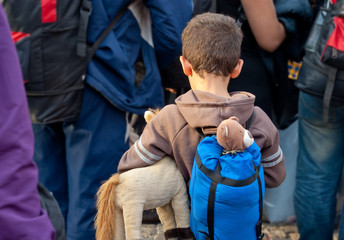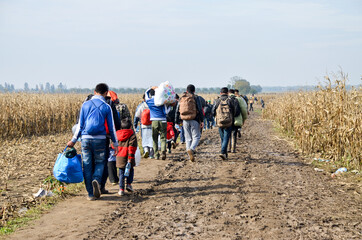
Critics argue that the HHS audit prompts inquiries into potential exploitation of migrant minors by nonfamily individuals for child labor.
According to a recent audit conducted by the Health and Human Services Department, the Biden administration has released 344 unaccompanied migrant children to reside with nonfamily sponsors who are already hosting three or more unaccompanied kids. This revelation has raised concerns among advocates who fear that some minors may be vulnerable to exploitation for child labor by unfamiliar individuals who sponsor them.
The audit, carried out by the Office of Refugee Resettlement, the governing body responsible for the care and release of unaccompanied minors, has also indicated a rise in the number of children placed with distant relatives or nonfamily sponsors in both absolute terms and as a percentage of all unaccompanied minors, comparing figures from 2021 to 2022.
Wendy Young, president of Kids in Need of Defense, an organization dedicated to advocating for unaccompanied migrant children, expressed their observations in relation to this issue. Young stated, “In our own experience, we have witnessed instances where children are placed in environments where they may not be familiar with the person and are treated as lesser members of the family, often facing pressure to engage in labor.”
Upon the arrival of unaccompanied migrants under the age of 18 in the United States, they undergo processing by the Health and Human Services (HHS) and are subsequently released within the country. However, prior to their release, they must be transferred into the care of an approved sponsor, who is typically, but not always, a family member. HHS data reveals that since 2012, over 600,000 unaccompanied migrant children have been released by the Office of Refugee Resettlement (ORR), with more than one-third of those releases occurring during the Biden administration.
In the year 2021, the government released a total of 138,917 unaccompanied minors. Among them, 11.8%, or 16,456 children, were placed with distant relatives or nonfamily sponsors. In 2022, there was a slight decrease in the number of unaccompanied minors released, totaling 124,781. However, the percentage of those released to nonfamily sponsors increased to 14%, with 18,004 children being placed in such arrangements.
The audit conducted by the ORR confirmed that the vetting process for nonfamily sponsors adhered to guidelines, including mandatory FBI background checks, sex offender checks, requests for child abuse and neglect registry information, and, in some cases, home studies. It is worth noting that the number of children released to nonfamily sponsors hosting three or more unaccompanied kids accounts for less than 1% of the overall number of children released to distant relatives or nonfamily members since the beginning of 2021, as stated by agency officials.
HHS Secretary Xavier Becerra emphasized the crucial obligation to provide care and protection to all children, regardless of their circumstances. He expressed HHS’s commitment to taking the responsibility of temporary custody and placement of unaccompanied children seriously. Becerra highlighted that the audit findings confirmed the efforts made by the Office of Refugee Resettlement (ORR) to ensure the well-being of unaccompanied children, particularly those who have experienced significant trauma. The placement and sponsor vetting processes were noted as integral to ORR’s diligent work, with the majority of children being placed under the care of a parent or close relative.
Becerra further stated that HHS would continue to fulfill its role in safeguarding the safety and welfare of unaccompanied children, including collaborating with the Department of Labor and other partners to combat child labor. He emphasized the expectation for employers and companies to abide by the law concerning child labor.

Recent reports of increasing child labor exploitation have brought ORR under heightened scrutiny. A Labor Department investigation revealed that over 100 children, many of whom were unaccompanied minors from Guatemala, were employed in cleaning Midwestern slaughterhouses. Labor officials disclosed a 69% increase since 2018 in the number of children employed in violation of labor laws. Concerns have been raised that changes in ORR’s guidance during the influx of unaccompanied children in March 2021 may have reduced scrutiny on sponsors who could exploit children for labor.
ORR conducted an examination of a subset of over 34,000 children released to distant relatives or nonrelative sponsors. The vetting process for sponsors hosting three or more unaccompanied kids was analyzed for 344 children. Immigrant advocates argue that sponsors of this nature could potentially be involved in child labor trafficking, raising concerns about the oversight required for such releases.
Wendy Young, speaking to NBC News, expressed her lack of surprise regarding the number of unaccompanied children being released to nonrelatives but emphasized that these releases necessitate the highest level of scrutiny. She remarked, “We are witnessing too many troubling examples where this process is failing,” adding, “The most extreme situation is evidence of their release into exploitative labor conditions.”
Monica Meier, the head of the social work program at the Immigrant Legal Center in Nebraska, shared that her team has assisted over 1,300 unaccompanied migrant children who have arrived in Nebraska since 2021. Meier explained that most of these children are placed with family members, making a nonfamily sponsor housing three or more children a cause for concern. She emphasized that unaccompanied children are eager to work and are particularly susceptible to labor trafficking. Meier highlighted their lack of awareness regarding age restrictions and hazardous working conditions, such as overnight shifts at meatpacking plants with dangerous chemicals. This vulnerability allows exploitation to occur as they strive to earn money.
The breakdown of the specific locations within the country where the 344 released children were placed was not provided in the HHS audit.
After the child is released to the sponsor’s care, the ORR attempts to contact both the child and the sponsor at least three times within 30 days for follow-up. However, the audit revealed that in 46 out of the 344 cases, neither the child nor the sponsor could be reached. HHS asserts that it successfully reaches the child, the sponsor, or both in over 80% of cases.
The audit also delved into 172 of the 344 cases in detail. Among these cases, 12 children were found to have run away, and an additional 12 were referred to child protective services.
In response to the concerns raised, HHS has announced the launch of an Innovation and Accountability team within the ORR director’s office. This team aims to identify and address potential instances of fraud, abuse, and exploitation involving unaccompanied migrant children within the next four months.
To address the increasing worries about unaccompanied children engaging in illegal work, HHS and the Labor Department entered into a new memorandum of understanding in March. This agreement formalized the sharing of information between the two agencies.
Labor and HHS officials have faced pressure to disclose any connections between the rise in child labor and the release of unaccompanied children. GOP members of Congress on the House Education and Workforce Committee recently sent a letter to Labor Department officials, urging them to provide information on the number of children under HHS’s care who have been identified as victims of child labor.
Furthermore, the HHS Office of Inspector General is currently conducting an evaluation of how sponsors for unaccompanied minors are vetted by the ORR. A report on this matter is expected to be released this summer, according to an agency spokesperson.


